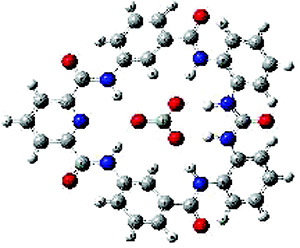Jul 15 2009
The accidental discovery of a bowl-shaped molecule that pulls carbon dioxide out of the air suggests exciting new possibilities for dealing with global warming, including genetically engineering microbes to manufacture those CO2 “catchers,” a scientist from Maryland reports in an article scheduled for the August 3 issue of ACS’ Inorganic Chemistry, a bi-weekly journal.
 An unusual bowl-shaped molecule (shown) that pulls carbon dioxide out of the air may provide exciting new possibilities for dealing with global warming, a scientist says. Credit: The American Chemical Society
An unusual bowl-shaped molecule (shown) that pulls carbon dioxide out of the air may provide exciting new possibilities for dealing with global warming, a scientist says. Credit: The American Chemical Society
J. A. Tossell notes in the new study that another scientist discovered the molecule while doing research unrelated to global climate change. Carbon dioxide was collecting in the molecule, and the scientist realized that it was coming from air in the lab. Tossell recognized that these qualities might make it useful as an industrial absorbent for removing carbon dioxide.
Tossell’s new computer modeling studies found that the molecule might be well-suited for removing carbon dioxide directly from ambient air, in addition to its previously described potential use as an absorbent for CO2 from electric power plant and other smokestacks. “It is also conceivable that living organisms may be developed which are capable of emplacing structurally ion receptors within their cell membranes,” the report notes.